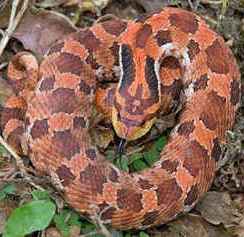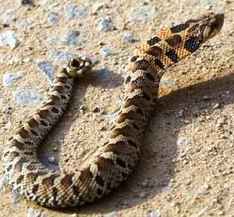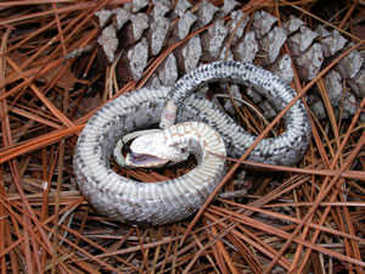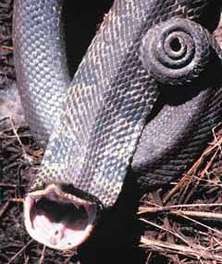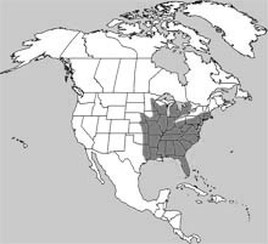Eastern hognose snakeHeterodon platirhinos |

Custom Search
|
|
The Eastern hognose snake or eastern hog-nosed snake (Heterodon platirhinos) is a harmless non-venomous colubrid species endemic to North America with no subspecies currently recognized.
The Eastern hog-nosed snake is native to the Nearctic ecozone and found in the eastern half of the US from central New England to Florida, southern New Hampshire, eastern Texas, western Kansas and also in southern Canada. The species is absent from some areas in the Great Lakes region like south of Lakes Erie and Ontario and eastern parts of Wisconsin. The eastern hognose snake inhabits coastal areas, pine forests, deciduous woodlands, prairies, meadows, pastures, woodlands with sandy soil, fields, and farmlands. The eastern hognose measures on average 20 to 30 inches (50 to 76 cm) with a thick body and a broad triangle-shaped head. The females are larger than males. Their color pattern is extremely variable and ranges from yellow, olive, brown, gray, black, or even orange. Sometimes they are blotched or checkered with large rectangle-shaped spots and blotches down their back and sides, but it can be a solid color. Its belly is usually gray, cream, or yellow in color. The eastern hognose longevity in the wild is unknown but have been known to live for 11 years in captivity. They are preyed upon by large birds of prey, owls, hawks, skunks, opossums and sometimes other snakes like the milk snake or the blue racer.
The eastern hognose solitary animals and mostly active during the day, but they sometimes restrict their activity to morning and evening time in hot weather. They are good burrowers and make their own burrows, enlarge or use abandoned dens of other animals like foxes, skunks or woodchucks, to hibernate in the winter from late October to early April. The species gets its common name from its distinctive upturned snout, used to dig in the soil and leaf litter. When confronted or feeling threatened the eastern hognose, will raise the head and puff and hiss loudly, flatten the neck skin, much like a cobra hood and lunge itself towards the threat. Because of this behavior, it's sometimes called the "puff adder" but it's not to be confused to the "real" and highly venomous puff adder found in Africa. They even play dead, rolling on their back with their mouth open or excrete a foul musk to escape predators, in a behavior similar to that of the european grass snake. The eastern hognose are sold in the exotic pet trade, but this type of snakes are difficult to keep due to their specific diet requirements, as they can develop liver problems if fed on rodents. Subspecies / Taxonomy
The eastern hognose has no subspecies currently recognized, and was first described by Latreille in 1801. Diet / Feeding The Eastern hognose eats small mammals such as mice, salamanders, small reptiles and reptile eggs,frogs, small birds, and insects. But these snakes have specialized in eating poisonous toads using its nose to root around for toads in their burrows. With their digging abilities, wide mouths with flexible jaws and curved teeth they hunt the wide-bodied toads.They are immune to the toxins toads secrete, their immunity comes from enlarged adrenal glands which secrete massive amounts of hormones, used neutralize the powerful toxins present in the toads skin. Although the toads will often inflate themselves with air in an attempt to escape being eaten by the snake they rarely succeed. The eastern hognose has a pair of enlarged teeth located in the back of their mouth which are believed to be used to puncture those inflated toads. The species has specialized salivary glands which secrete a mild amphibian-specific venom that helps them subduing amphibians, though it's harmless to other animals and humans. Reproduction The eastern hognose mating season occurs in the spring from April to May, and they first mate when they are around 2 years old. They are oviparous and females lay from 8 to 40 eggs with an average about 25, in June or early July, and measure about 1 1⁄4 in × 1 in (33 mm × 23 mm). The eggs are laid under a rock or log or in a depression in the sandy soil and will hatch after about 60 days later, from late July to September. Females won't take care of the eggs or the young snakes once they hatch. The hatchlings are born with a length of about 6.5 to 8.3 inches (16.5 to 21 cm). Conservation / Threats The eastern hognose snake is classified as a Least Concern species on the IUCN Red List , due to the species presumed large population and wide distribution. Even though most of their natural habitat remains untouched, throughout their range habitat destruction affects them and their numbers have declined. The population numbers may continue to decline as the toad populations also decline, which seems to be the case in the eastern North America. Although the eastern hog-nosed snake is harmless it's often mistaken for venomous rattlesnakes, and many encounters with humans probably end with the snake being killed. They are also often victims of roadkill.
|
Did You Know?
In colder climates some snakes "hibernate" in the winter, this is called brumation, find more snake facts for kids. Scientific classification |
© 2014 Snake Facts About Us | Privacy Policy | Contact

